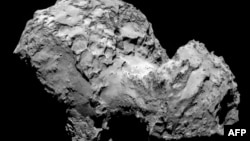A Soviet scientist credited with discovering the comet that a European spacecraft has landed on nearly tossed the initial evidence of her find in the trash.
In September 1969, Ukrainian-born astronomer and postgraduate student Svitlana Gerasimenko was on assignment in Soviet Kazakhstan scanning the heavens for comets and managed to snap photographs of several of these massive space rocks.
But the photographic plate showing an image of the comet that would eventually bear her name came out underdeveloped, she said.
"I was very upset that I allowed such a defect and initially even wanted to throw the plate out," Gerasimenko, who now works at the Institute of Astrophysics at Tajikistan's Academy of Sciences in Dushanbe, recalled in a 2004 interview with the Tajik news agency Asia-Plus.
Luckily, she remembered a teacher's advice to hold on to faulty photographic plates to analyze the mistakes and prevent such slip-ups in the future.
The image proved crucial in the discovery of the 67P/Churyumov-Gerasimenko comet. A European Space Agency (ESA) spacecraft landed on it on November 12, the first such landing in history.
After returning to Kyiv, Gerasimenko and fellow Ukrainian-born astronomer Klim Churyumov, who led the expedition, analyzed the defective plate. They assumed a spot near the center of the image was a comet known as Comas Sola, Gerasimenko told Asia-Plus.
Their analysis, however, showed that the celestial position of the comet did not match that of Comas Sola. They found the same comet on other photographic plates and shipped their findings off to renowned U.S. astronomer Brian Marsden at Harvard University, who confirmed to them that the comet was new, Gerasimenko said.
Churyumov, currently an astronomer at Kyiv State University, told "Science Magazine" on November 11 about the expedition to the mountains outside Almaty, Kazakhstan, that yielded the discovery of the new comet.
"The whole world knows about this comet. At the beginning, we didn't know anything. We didn't have such a nice shape. It was just a bright dot," said Churyumov, 77, adding that "it was clear that it was not a star."
In an interview published on the ESA's website in October, Churyumov said he had been following "every step" of the mission to land the space probe ever since the ESA selected "our comet" as its target in 2003.
Both Churyumov and Gerasimenko, who have remained in touch over the years, attended the launch of the probe and its mothership, known as "Rosetta," from French Guiana in 2004.
He said in the interview for the ESA that he would like to study the "unique archive of data" that the Rosetta mission may yield. "There will be a lot of mysteries that will need to be solved and I would like to participate in this research," Churyumov said.
Gerasimenko said in a separate interview for the ESA published in October that the initial images of the comet discovered by the duo resonated with her deeply. "I had a feeling that I was seeing something so special, so near and dear to me," she said.
Speaking at an ESA control center in Cologne, Germany, shortly before the spacecraft landing on November 12, Gerasimenko added that she was an admirer of the comet's shape. "It reminds me of a lady's boot," she said.
Churyumov called the event "a great day in the cometary science, science in general, and also in the history of human civilization."
"All have seen [by now] the nucleus of this comet," he said at an ESA control center in Darmstadt, Germany. "I think [this mission] is a triumph of celestial mechanics. It is a unique, unprecedented experiment in the history of science."








